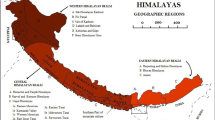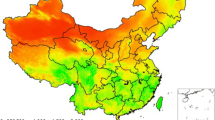Abstract
Research on the geological data of Hunshandake Desert in China monsoon region revealed that Holocene summer monsoon had experienced six prevailing periods and seven weakening periods. The climatic humidity and the vegetation had also undergone the similar periodical variation influenced by the monsoon periodicity. The period when summer monsoon prevailed or winter monsoon weakened and climatic humidity and vegetation coverage relatively increased, corresponded to the global warming events; whereas the period when summer monsoon weakened or winter monsoon prevailed and climatic humidity and vegetation coverage relatively decreased, corresponded to the arid events in middle to low latitudes and the cold events in North Atlantic. As for the changing regularity of summer monsoon intensity there were two distinct periodicities of 1456 years and 494 years, also these two periodicities had global significance.
Similar content being viewed by others
References
O’Brien, S. R., Mayewski, P. A., Meeker, L. D. et al., Complexity of Holocene climate as reconstructed from a Greenland ice core, Science, 1995, 270: 1962–1964.
An, Z., Porter, S. C., Kutzbach, J. E. et al., Asynchronous Holocene optimum of the East Asian monsoon, Quaternary Science Review, 2000, 19: 743–762.
**ao, J., Nakamura, T., Lu, H. et al., Holocene climate changes over the desert and loess transition of north-central China, Earth and Planetary Science Letters, 2002, 197: 11–18.
Masson, V., Vimeux, F., Jouzel, J. et al., Holocene climate variability in Antarctica based on 11 ice-core isotopic records, Quaternary Research, 2000, 54: 348–358.
Zhou, W. J., Lu, X. F., Wu, Z. K. et al., Peat record reflecting Holocene climatic change in Zoige Plateau and AMS rediocarbon dating, Chinese Science Bulletin, 2002, 47(1): 66–70.
Brachfeld, S. A., Banerjee, S. K., Guyodo, Y. et al., A 13200 year history of century to millennial-scale paleoenvironmental change magnetically recorded in the Palmer Deep, western Antarctic Peninsula, Earth and Planetary Science Letters, 2002, 194: 311–326.
Bond, G. C., Shower, W., Cheseby, M. et al., A pervasive millennial-scale in north Atlantic Holocene and glacial climates, Science, 1997, 278: 1257–1266.
Pinegina, T. K., Bourgeois, J., Bazanova, L. I. et al., A millennial-scale record of Holocene tsunamis on the Kronotskiy bay coast, Kamchatka, Russia, Quaternary Research, 2003, 59: 36–47.
Chen, F. H., Zhu, Y., Li, J. J. et al., Abrupt Holocene changes of the Asian monsoon at millennialand centennial-scales: evidence from Lake Sediment document in Minqin Basin, North China, Chinese Science Bulletin, 2001, 46(23): 1942–1947.
Li, S., Sun, W., Li, X. Z. et al., Deposition features and environmental evolution of Hunshandake Desert in Holocene, Journal of Desert Research (in Chinese), 1995, 15(4): 323–331.
Cui, H. T., Lui, H. Y., Yao, X. S., The finding of a paleo-spruce timber in Hunshandake sandy land and its paleoecological significance, Science in China, Series D, 1997, 40(6): 599–604.
Liu, H. Y., Xu, L. H., Cui, H. T., Holocene history of desertification along the woodland-steppe border in north China, Quaternary Research, 2002, 57: 259–270.
Kukla, G., Heller, F., Liu, X. M. et al., Pleistocene climates in China dated by magnetic susceptibility, Geology, 1988, 16: 811–814.
Liu, X. M., Liu, D. S., John, S., Magnetic mineral characters of China loess and its paleaoclimate significance, Quaternary Research (in Chinese), 1993, (3): 281–287.
An, Z. S., Porter, S., Kukla, G. et al., Magnetic susceptibility proofs on monsoon change in recent 130000 years on Loess Plateau, Chinese Science Bulletin (in Chinese), 1990, 35(7): 529–532.
Huang, R. C., Palaeoclimate evolution documented by the elementary migration and conglomeration in terrestrial sediments, Memories of Lanzhou Institute of Geology, Academia Sinica, Bei**g: Science Press, 1982, 137–160.
Gasse, F., Arnold, M., Fontes, J. C., A 13000-year climate record from west Tibet, Nature, 1991, 353: 742–745.
Zhou, W. J., Donahue, D., Porter, S. C. et al., Variability of monsoon climate in east Asia at the end of the last glaciation, Quaternary Research, 1996, 46: 219–229.
Zaady, E., Offcer, Z. Y., Shachak, M., The content and contributions of deposited aeolian organic matter in a dry land ecosystem of the Negev Desert, Israel, Atmospheric Environment, 2001, 35: 769–776.
Lu, H. Y., An, Z. S., Paleoclimatic significance of grain size of loess-palaeosol deposit in Chinese Loess Plateau, Science in China, Series D, 1998, 41(6): 626–631.
**ao, J. L., Porter, S. C., An, Z. S. et al., Grain size of quartz as an indicator of winter monsoon strength on the loess Plateau of central China during the last 130000 Year, Quaternary Research, 1995, 43: 22–29.
Gao, S. Y., Chen, W. N., **, H. L. et al., Holocene primary study of the desert evolution in southwestern edge of monsoon regions, China, Science in China, Ser. B (in Chinese), 1993, 23(2): 202–208.
Hong, Y. T., Hong, B., Lin, Q. H. et al., Correlation between Indian Ocean summer monsoon and north Atlantic climate during Holocene, Earth and Planetary Science Letters, 2003, 211: 371–380.
Shi, Y. F., Kong, Z. C., Wang, S. M., Climates and environments of the Holocene megathermal maximum in China, Science in China, Series B, 1994, 37(4): 481–493.
Cai, Y. J., Peng, Z. C., An, Z. S. et al., The δ18O variation of a stalagmite from Qixingcave, Guizhou Province and indicated climate change during Holonece, Chinese Science Bulletin, 2001, 40(22): 1904–1907.
Enzel, Y., Ely, L. L., Mishra, S. et al., High-resolution Holocene environmental changes in the Thar Desert, northwestern India, Science, 1999, 284: 125–127.
Chen, C. T. A., Lan, H. C., Lou, J. Y. et al., The dry Holocene Megathermal in Inner Mongolia, Palaeogeography, Palaeoclimatology, Palaeoecology, 2003, 193: 181–200.
Yang, B., Braeuning, A., Johnson, K. R., General characteristics of temperature variation in China during the last two millennia, Geophysical Research Letters, 2002, 29: 381–384.
Bianchi, G. G., Mccave, I. N., Holocene periodicity in north Atlantic climate and deep-ocean flow, south of Iceland, Nature, 1999, 397: 515–516.
**, Z. D., Shen, J., Wang, S. M., The medieval warm period in the Daihai area, Journal of Lake Science (in Chinese), 2002, 14(3): 209–216.
Stuiver, M., Braziunas, T. F., Grootes, P. M., Is there evidence for solar forcing of climate in the GISP2 oxygen isotope record? Quaternary Research, 1997, 48: 259–266.
Cronin, T. M., Dwyer, G. S., Kamiya, T. et al., Medieval warm period, litter ice age and 20th century temperature variability from Chesapeake Bay, Global and Planetary Change, 2003, 36: 17–29.
Wang, S. W., Ye, J. L., Gong, D. Y., Climate in China during little ice age, Quaternary Research (in Chinese), 1998, 18(1): 54–64.
Sirocko, F., Garbe-Schonberg, D., McIntyre, A. et al., Teleconnections between the subtropical monsoon and high-latitude climates during the last deglaciation, Scinece, 1996, 272: 526–529.
Stuiver, M., Braziunas, T., Sun, Ocean, Climate and atmospheric14CO2: An evaluation of causal and spectral relationship, Holocene, 1993, 3(4): 289–305.
Author information
Authors and Affiliations
Corresponding author
About this article
Cite this article
**, H., Su, Z., Sun, L. et al. Holocene climatic change in Hunshandake Desert. Chin. Sci. Bull. 49, 1730–1735 (2004). https://doi.org/10.1007/BF03184307
Received:
Accepted:
Issue Date:
DOI: https://doi.org/10.1007/BF03184307




